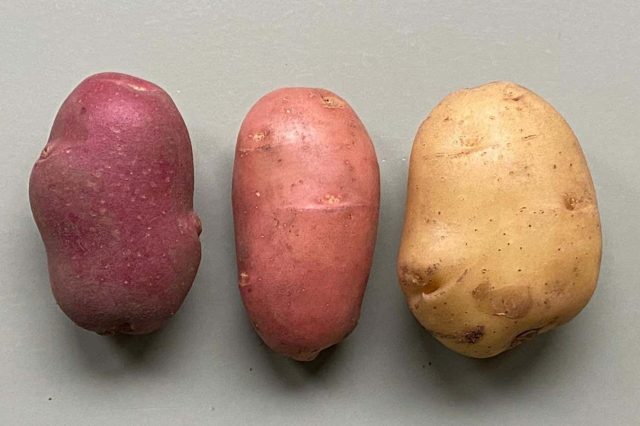
KeyGene’s new potato variety (centre) has the skin of Pimpernel (left) and the flesh of Bintje (right)
Courtesy of KeyGene
A new technique for creating fruit and vegetables with the skin of one variety and the flesh of another could make crops more resistant to pests and droughts.
A lot of the fruit and vegetables we eat comes from grafted plants created by cutting off part of one plant and replacing it with part of another. What makes grafting useful is that even plants that are too distantly related to hybridise can be grafted together. For instance, a desirable variety of fruit plant can be grafted onto a rootstock of another type that is resistant to pests and diseases.
Very occasionally, a shoot arises from the junction between grafted plants that is a strange mix of the two – called a graft chimera – with the outer layer of one plant and the insides of another. This can happen because shoots develop from three distinct layers of stem cells at their tip, one of which forms the skin of the plant. By chance, shoots from a graft junction can end up with a mix of stem cell types from the two plants.
Normally, creating a certain type of grafted plant requires performing a graft for each one you want to cultivate, so making large quantities is taxing. But graft chimeras can be propagated by taking cuttings from them or simply from their tubers, which would make them more desirable.
However, while researchers have occasionally deliberately created graft chimeras, it isn’t easy. Many of the known graft chimeras, such as the Bizzarria citrus, are a very rare accidental byproduct of conventional grafting.
Now, Jeroen Stuurman at KeyGene, a crop technology company in the Netherlands, says he has developed a reliable way to produce graft chimeras for the first time. He won’t reveal details of the method, but he says he has used it to create many different graft chimeras from varieties of potatoes, tomatoes and aubergines, and between sweet and chilli peppers.
For one graft-chimera potato, with the skin of a variety called Pimpernel and the flesh of another called Bintje, KeyGene has been awarded plant breeders’ rights – the horticultural equivalent of copyright. This is a first for a graft chimera. Getting these rights shows that producing them is a potentially viable business, says Stuurman. “For us, this was the signal that we can now go into the next step.”
The company is now planning to create graft chimeras with properties such as resistance to pests and diseases. Pest resistance is often due to hair-like structures called trichomes on the surface of plants, which may secrete repellents or sticky substances to trap insects, says Stuurman. Trichomes are very hard to transfer between plant varieties with conventional breeding or genetic engineering as they involve many genes, but his method allows existing varieties to be effectively given a “skin transplant”.
Because potatoes are already grown from tubers rather than seeds, farmers could start growing such graft chimeras tomorrow if they chose, says Stuurman. “There is no need for any change in the way things are grown.”
“It’s really interesting that they can make stable graft chimeras that have commercially relevant properties,” says Charles Melnyk at the Swedish University of Agricultural Sciences. “I’m not aware of this being done before, so their finding is really significant.”
Graft chimeras have a tendency to be unstable, meaning they can revert back to one of the original forms, but KeyGene must have overcome this to get plant breeders’ right, says Colin Turnbull at Imperial College London. “The novelty seems to be the stability of the ‘skin graft’ such that they have a marketable variety.”
Topics:










